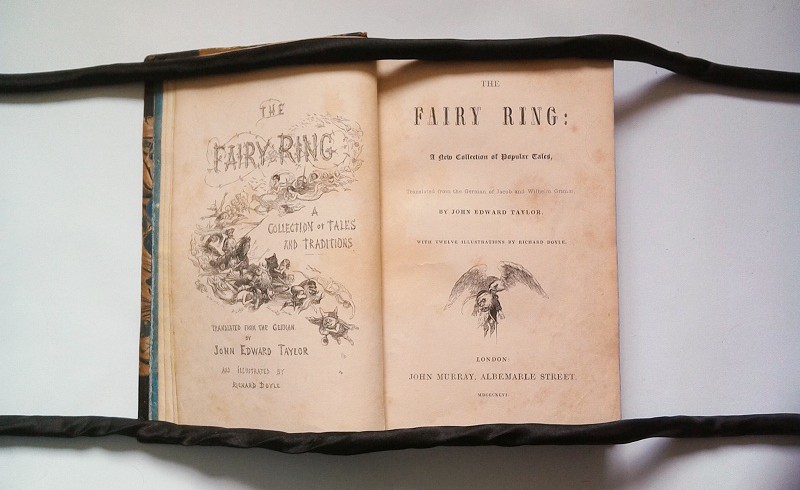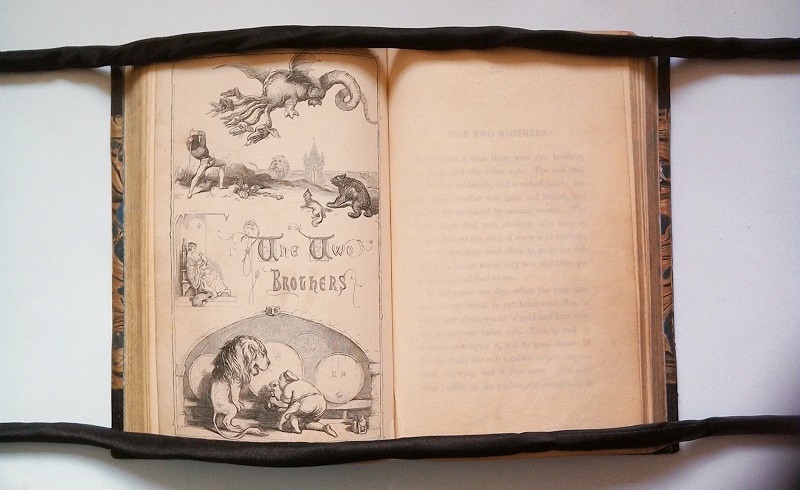 My new book Yuletide Truce, which comes out next week, starts with dueling reviews of a collection of fairy tales: The Fairy Ring, published on 9 December 1845 (though the title page gives the year of publication as 1846), in time for the Christmas season. It contains fairy tales from the collection of the Brothers Grimm, translated by John Edward Taylor.
My new book Yuletide Truce, which comes out next week, starts with dueling reviews of a collection of fairy tales: The Fairy Ring, published on 9 December 1845 (though the title page gives the year of publication as 1846), in time for the Christmas season. It contains fairy tales from the collection of the Brothers Grimm, translated by John Edward Taylor.
John Edward Taylor was the cousin of Edgar Tylor, the man who in 1823 had produced the very first English translation of a selection of the Grimms’ fairy tales. He published them as German Popular Stories, with a second volume following three years later.
While Germany had seen a renewed interest in fairy tales since the late 18th century, it were the Taylors’ translations of the Grimms’ stories and, later on, Mary Howitt’s translation of Hans Christian Andersen’s fairy tales that led to a similar fashion in Britain, where it would eventually produce a new genre, fantasy fiction, in the second half of the 19th century.
The publication history of the Grimms’ fairy tales at home and abroad is in many ways a peculiar one. When the first edition of the Kinder- und Hausmärchen was published in 1812/15, it bore evidence of the conflicting aims the Grimms pursued. One the one hand, the collection was meant to be a scholarly project documenting a specific form of German “folk literature,” hence the extensive notes that accompanied the collection. There, the Grimms tried to establish the history of individual tales as well as document connections to the folk literature of other nations. On the other hand, the Grimms built up a fictional version of how they had obtained the tales to establish them more firmly as authentic folk tales. Which is why even today, there’s the persistent myth that Grimms marched from village to village, knocking on people’s doors and asking to be fairy tales, when they received the majority of their tales from acquaintances, in particular middle-class women.
The first edition of the Kinder- und Hausmärchen received mixed reviews, and many felt that, despite the “children” in the title, the tales weren’t really suitable for a young audience, not the least because many of them contained very clear sexual allusions. In subsequent editions, the existing tales were edited (mainly by Wilhelm) to bring them more in line with patriarchal, middle-class values and more tales were added to the collection.
Thus, the text of the Kinder- und Hausmärchen was constantly in flux, and as a consequence there is little conformity among the English translations of the collection. For not only was their selected material taken from different editions of the original collection, but the translators themselves also tended to heavily edit the tales. This is already evident in the very first translation from 1823: Edgar Taylor left out references to the devil and shied away from sexual allusions, which is why his version of “The Frog King” is heavily altered.
But the most important change to the German source material was the inclusion of illustrations by George Cruikshank. This new feature proved to be so successful that it inspired the Grimms to let their brother Ludwig Emil Grimm illustrate their own Kleine Ausgabe of 1825.
Like Edgar Taylor’s German Popular Stories, his cousin’s translation The Fairy Ring was also illustrated — and by one of the most popular artists of the 1840s: Richard Doyle.
 Christoper Foreman, one of my characters in Yuletide Truce, takes issue both with John Edward Taylor’s text and Doyle’s illustrations, which allowed me to write a snarky Victorian style book review. 🙂
Christoper Foreman, one of my characters in Yuletide Truce, takes issue both with John Edward Taylor’s text and Doyle’s illustrations, which allowed me to write a snarky Victorian style book review. 🙂
This is what Kit Foreman has to say about the illustrations:
“The illustrations of The Fairy Ring were done by Richard Doyle, whose illustrations in Punch regularly delight that magazine’s readership. It is, however, debatable whether his whimsical style is quite suitable to adequately depict fearsome dragons, malicious dwarves, and giants, no matter into what raptures of praise the pictures have thrown our colleague at Munro’s. Are we really to believe in the fearsomeness of a dragon whose heads resemble those of sad puppy dogs?”
Oh dear! Poor Dicky Doyle! (And poor Aigee, whose review Kit trashes so mercilessly!)
If you’d like to get a longer sneak peek at Yuletide Truce (and Kit’s review!), check out the excerpt on my website!
Yuletide Truce
London, 1845
It’s December, Alan “Aigee” Garmond’s favorite time of the year, when the window display of the small bookshop where he works fills up with crimson Christmas books and sprays of holly. Everything could be perfect — if it weren’t for handsome Christopher Foreman, the brilliant writer for the fashionable magazine About Town, who has taken an inexplicable and public dislike to Aigee’s book reviews.
But why would a man such as Foreman choose to target reviews published in a small bookshop’s magazine? Aigee is determined to find out. And not, he tells himself, just because he finds Foreman so intriguing.
Aigee’s quest leads him from smoke-filled ale-houses into the dark, dingy alleys of one of London’s most notorious rookeries. And then, finally, to Foreman. Will Aigee be able to wrangle a Yuletide truce from his nemesis?
WARNING: Contains a very grumpy writer, snarky Victorian book reviews, a scandalous song, two men snogging, and fan-girling over Punch.
Now available for pre-order: Amazon US | Nook | ibooks | Kobo


Interesting post, Sandra! I love learning about the history behind fairy tales and their origins and variations. And although you focused on Grimms, the post reminds me of how much I used to like the Andrew Lang “color” fairy books. Something to explore again when I have time.
Thanks, Elena! The Rainbow Fairy Books are so beautiful! I learned about them only a few years ago when I was teaching a class on fairy tales.